Celestial 48
By Zuzana Prochazka
The Celestial line of light to moderate displacement center cockpit cruisers is from Xiamen Celestial Yachts originally based in Hong Kong, China. These rare boats have a long history, but many of the details are murky or downright inaccurate. Today, you may see their design attributed to anyone from Sparkman & Stevens to Ted Brewer or Robert Perry. After some digging and email exchanges with Messrs. Perry and Brewer and with S&S, I learned that Bryce Fuhriman based his first boat, a 46, on a Brewer design and added his own changes. He then put together an international team of American ownership, Australian management and Chinese craftsmanship to build this line of semi-custom bluewater boats destined for the North American market. But he started his venture in 1980 and the next five years proved to be difficult in terms of generating sufficient funds and fighting a troublesome market in the US. Fuhriman experimented with several sizes including 43s, 44s, 46s, 48s and 56s. By 1985, the line mainly focused on the 48 foot ketch.
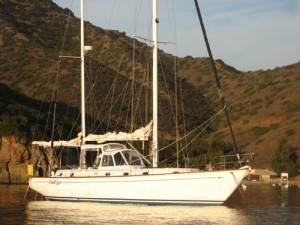
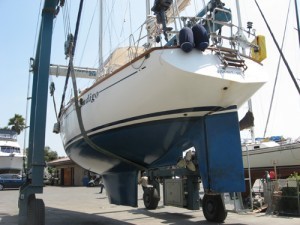
The 48 has a fully encapsulated, elongated fin keel consisting of two solid lead castings. The skeg hung rudder is very large and should be checked for water at haul out. The 48 underbody is very full and round which makes her heel to a certain point rather quickly, but then the 44% ballast to displacement ratio takes over and she stabilizes and picks up and goes. At the sea trial, we were thrilled to see her move like a luxury car with only 8-10 knots across the deck and we've often seen her do 9 knots in an 18 knot breeze.
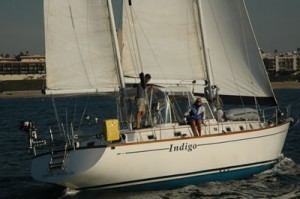
The hull of the 48 is balsa cored with reinforcement at the chainplates, rudder shaft and propeller shaft. The balsa is cut away and sealed with epoxy around the through hulls and is omitted entirely in the keel sides and on the centerline. Like Indigo, most of these boats came from the factory with teak decks which some owners have since replaced with glass and nonskid.
The 48 has substantial bulwarks for good footing offshore and strong hawse holes that minimize chafe on the teak caprail. However, beware the placement of the scuppers which seem to miss the bulk of the water traveling down the gunwales and therefore standing pools form on the decks.
Cockpit, Deck & Rigging
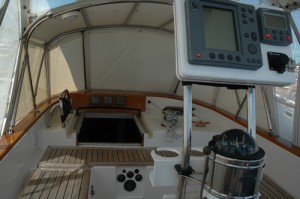
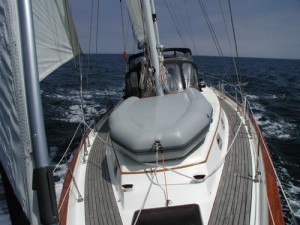
Indigo's sail area is a little less than the original 990 square feet since her boom was raised to make room for a full-sized bimini. The Celestial 48 was designed as a ketch with a keel stepped double spreader rig. When examining these boats, be sure to check the condition of the mast step. Indigo's mast step was basically a large chunk of wood encased in fiberglass that had rotted due to a leak from the forward fresh water tank and the mast had sunk enough to make the standing rigging slack.
Although high, the masthead rig is not overpowering since it is a split rig with a mizzen that is surprisingly large for a ketch. This is not the usual mizzen boom on which to dry laundry. The 48 does quite well on a beam or broad reach under a jib and jigger configuration, running comfortably and on her feet at 8 knots or higher.
Indigo's mainsheet was originally led forward and then back to the cockpit much like on an aft cockpit layout. However, this did not let the helmsman have easy control, especially if singlehanding. Unfortunately, given the ketch rig, there is no convenient place to install a mainsheet winch so we added a 4:1/16:1 cascading purchase to control and fine tune the mainsail trim which works well.
The cockpit is compact and trimmed with teak. There is great additional storage beneath both port and starboard seats and plenty of room for instruments under the dodger. There are two aft lazarettes which make for a fantastic garage.
Layout & Accommodations
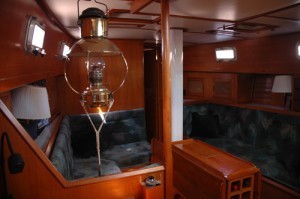
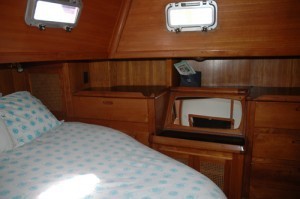
The Celestial layout is a modern fore and aft cabin design that features 6'4" headroom. The spacious interior begins with a 6'6" vee-berth forward followed by a head and shower combination to port. The saloon has a centerline drop-leaf table with a built-in eight bottle wine rack and settees along either side. The galley is to starboard and the main complaint here is limited counter and drawer space but food storage space is good. The sinks are near the centerline and close to the companionway steps so the cook doesn't have to go far to get food to the crew in the cockpit.
The forward facing nav station sits at the beginning of the passageway that leads aft on the port side with door access to the crawl-in engine room. Originally, some of the 48s had a separate freezer outboard of the passage but many owners removed the freezer and replaced it with a voluminous storage compartment that houses all the tools and spares, a handy feature as it is directly across from the engine room. A wet locker is near the companionway which has a built-in locker in each step. The entire boat has a spectacular teak interior with 23 hand-caned lockers that provide incredible storage. Ventilation is provided by fifteen opening ports and seven opening hatches.
The luxurious owner's suite aft on the 48 came in a variety of layouts but primarily there is a king-sized centerline bunk which allows sleeping fore and aft or athwartships which is handy in a seaway. The aft head has a dedicated (not a walk-through) separate shower. Another nice feature is that the emergency tiller attaches on deck unlike many center cockpit boats that feature it under the aft bunk, so emergency steering allows for good visibility.
Systems & Mechanical
The 48 has a dedicated, well-insulted and well-lit, crawl-in engine room that allows access to all sides of the 62HP Perkins 4-154. Many of these boats originally came with 62 HP Lehmans as well. One thing to check with the 48s is the bonding system. Our copper stripping had been disconnected in several places leaving us with electrolysis issues. One of the problems that caused was wear on the prop which was replaced with a 3-blade Maxprop after survey.
The anchor locker allows for the chain to slip down and below the vee-berth thereby pushing much of the weight lower and farther aft. On deck, there is a substantial opening compartment into the anchor well which allows for storage of docklines and other smaller objects. The bow roller is a bit undersized for a yacht of this class and we will be upgrading Indigo's to bring the anchors farther forward and away from the hull.
Tankage on these boats is phenomenal. Originally, the Celestial 48s were spec'd with 250 gallons of fuel and 250 gallons of fresh water. All the tanks are fiberglass, on the centerline beneath the cabin sole. However, many owners requested different tank configurations so you may want to investigate the actual capacity on any boat you view. The 48s were built with a minimal number of through hulls which is good from the perspective of having fewer holes in the boat. It does mean however, that grey water is stored in the sump and then pumped overboard. This means that the cook must be extra zealous in wiping off dishes before actually washing the rest of the debris into the sump.
Wrap Up
Celestials are still built today. The 48s are now sloops and cutters and are primarily sold in the European market. Several brokerages import the new 50s which are also sloops but have added a very large deck house that creates the look and feel of a tall motorsailor. If you look closely at the hull shape however, you'll still see the same lines as the 48, graceful, clean and powerful.
At press time, there are four Celestial 48s listed on Yachtworld and their price ranges from $130,000 to $220,000 for mid-eighties models. A 1985 boat in average condition would have a BUC value of around $160,000. Since so few of the old 48s were built, the relative obscurity of these vessels depresses the market price for this class of boat which means there is a tremendous amount of value to be picked up by anyone looking for a serious bluewater boat that can take you extended cruising just about anywhere.
Specs for Celestial 48 Ketch
Designer: Bryce Fuhriman et alLOA: 48'0"
LWL: 39'4"
Beam: 13'6"
Draft: 6'
Ballast: 11,800 lbs
Displacement: 27,000 lbs
Sail Area: 990 sq ft
Fuel Tankage: 250 gallons
Water Tankage: 250 gallons
Ballast/Disp 44%
Disp/Length 198
SA/Disp 17.67
Zuzana Prochazka. Zuzana is a freelancer and a regular contributor to Sea Magazine, SAIL, Latitudes and Attitudes, Lakeland Boating, Yachtworld and Boats.com. Her work has appeared in Santana, Voyaging, Good Old Boat, Reeds Nautical Almanac, and the Los Angeles Times Sunday Magazine, as well as online at underwatercolors.com, sailingbreezes.com, catamarans.comand floridascubanews.com. She is president of Boating Writers International (BWI) and has served as Innovation Awards judge at the IBEX, Miami, and MAATS shows for several years. Currently, she serves as the chairperson for the BWI New Products Committee and as a judging chair for the BWI Annual Writing Contest. Zuzana's gear and boat review blog is TalkoftheDock .
Share on Facebook



